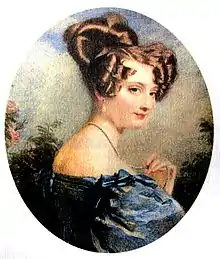Lady Margaret Herschel | |
|---|---|
 | |
| Born | Margaret Brodie Stewart 1810 |
| Died | 1884 |
| Nationality | United Kingdom of Great Britain and Ireland |
| Occupation(s) | artist and hostess |
| Spouse | John Herschel |
Margaret Brodie Stewart became Lady Margaret Herschel (1810–1884) was a British botanical artist and hostess. While she was in South Africa, she and her husband made over a hundred botanical paintings of wild flowers, which they brought back to Europe for study. Her husband was one of the leading scientists in Victorian Britain.
Life
Margaret Brodie Stewart was born in 1810.[1] Her father was Alexander Stewart DD, a Scottish Presbyterian minister and Gaelic scholar.[2]
She married her cousin John Herschel on 3 March 1829[2] in Edinburgh.
Visit to South Africa

The voyage to South Africa was made so that her husband could catalogue the stars, nebulae, and other objects of the southern skies.[3] Her husband had his own inherited money and he paid £500 for passage on the S.S. Mountstuart Elphinstone. Together with their three children they departed from Portsmouth on 13 November 1833.[2] They arrived in Cape Town on 15 January 1834 and chose to live at Feldhausen, an old estate in Claremont, a suburb of Cape Town, where her husband set up a private 21 ft (6.4 m) telescope. He collaborated with Thomas Maclear, the Astronomer Royal at the Cape of Good Hope and the two families became close friends.

Herschel and her husband between 1834 and 1838 produced 131 botanical illustrations showing Cape flora. They used a camera lucida to obtained outlines of the specimens and Margaret dealt particularly with the details. Their portfolio had been intended as a personal record, and despite the lack of floral dissections in the paintings, their accuracy made them valuable. 112 of their flower studies were collected and published as Flora Herscheliana in 1996.[4]
When HMS Beagle called at Cape Town, Captain Robert FitzRoy and the young naturalist Charles Darwin visited Herschel on 3 June 1836. Later on, Darwin would be influenced by Herschel's writings in developing his theory advanced in The Origin of Species.[5]
They returned to England in 1838, where her husband became a baronet, of Slough in the County of Buckingham and she became Lady Margaret Herschel.[3]
Death and legacy
Lady Margaret Herschel died in 1884. Besides the posthumus publication Flora Herscheliana, some of her letters are in Trinity College[1] and others are in the British Library.[6]
Private life
She had married her cousin John Herschel on 3 March 1829[2] in Edinburgh, and they had nine daughters and three sons:[7]

- Caroline Emilia Mary Herschel (31 March 1830 – 29 January 1909),[8] who married the soldier and politician Alexander Hamilton-Gordon
- Isabella Herschel (5 June 1831 – 1893)
- Sir William James Herschel, 2nd Bt. (9 January 1833 – 1917),
- Margaret Louisa Herschel (1834–1861), an accomplished artist
- Prof. Alexander Stewart Herschel (1836–1907), FRS, FRAS[1]
- Col. John Herschel FRS, FRAS, (1837–1921) surveyor
- Maria Sophia Herschel (1839–1929)[1] married Henry Hardcastle[9]
- Amelia Herschel (1841–1926)[1] married Sir Thomas Francis Wade,[8] diplomat and sinologist
- Julia Herschel (1842–1933) married on 4 June 1878 to Captain (later Admiral) John Fiot Lee Pearse Maclear
- Matilda Rose Herschel (1844–1914), a gifted artist, married William Waterfield (Indian Civil Service)[8]
- Francisca Herschel (1846–1932)
- Constance Anne Herschel (1855–20 June 1939)[8]
References
- 1 2 3 4 5 "Herschel, Margaret Brodie (1810–1884), wife of Sir John Herschel – archives.trin.cam.ac.uk". archives.trin.cam.ac.uk. Retrieved 27 January 2023.
- 1 2 3 4 Crowe, Michael J. (23 September 2004). Herschel, Sir John Frederick William, first baronet (1792–1871), mathematician and astronomer. Vol. 1. Oxford University Press. doi:10.1093/ref:odnb/13101.
- 1 2 "Herschel, Sir John Frederick William, 1792–1871, astronomer". NAHSTE project. University of Edinburgh. Archived from the original on 10 May 2007.
- ↑ Warner, Brian; Rourke, John (1996). Flora Herscheliana. Sir John and Lady Herschel at the Cape, 1834 to 1838. Johannesburg: The Brenthurst Press. ISBN 9780909079550. The book also includes work by Charles Davidson Bell and Thomas Bowler.
- ↑ John Herschel, Physical Geography (1861), p. 12.
- ↑ "Vol. II. (ff. 209). Margaret Brodie Herschel, wife of Sir J. F. W. Herschel: Letters to,: 1830–1846. Astronomy: Letters of Miss C. L. Herschel rel. to: 182... – British Library". searcharchives.bl.uk. Retrieved 27 January 2023.
- ↑ Burke, Sir Bernard; Burke, Ashworth P. (1914). "Herschel: Sir William James Herschel, 2nd Bart.". A Genealogical and Heraldic History of the Peerage and Baronetage, the Privy Council, Knightage and Companionage (76th ed.). London: Harrison and Sons. pp. 1004–1005. Retrieved 17 November 2019.
- 1 2 3 4 5 "Constance Anne (née Herschel), Lady Lubbock; Caroline Emilia Mary (née Herschel), Lady Hamilton-Gordon; Margaret Louisa Marshall (née Herschel); Isabella Herschel; Francisca ('Fancy') Herschel; Matilda Rose Waterfield (née Herschel) – National Portrait Gallery". www.npg.org.uk. Retrieved 27 January 2023.
- ↑ "Isabella Herschel; Maria Sophia Hardcastle (née Herschel); Sir John Frederick William Herschel, 1st Bt - National Portrait Gallery". www.npg.org.uk. Retrieved 29 January 2023.